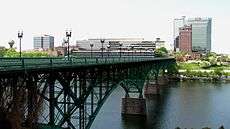Gay Street Bridge
The Gay Street Bridge is a vehicle bridge that crosses the Tennessee River in Knoxville, Tennessee, United States. Completed in 1898, the 1,512-foot (461 m) bridge[1] is the oldest of four vehicle bridges connecting Downtown Knoxville with South Knoxville, the other three being the Henley Street Bridge, the Buck Karnes Bridge (Alcoa Highway), and the James C. Ford Memorial Bridge.

Design
The bridge is a steel spandrel-braced (cantilever) arched design with a concrete deck.[2] There are five arched trusses, each 252 feet (77 m) long, and two 126-foot (38 m) approach spans at each end, all supported by a foundation of stone piers. The deck is 42 feet (13 m) wide, and consists of two vehicle lanes, each flanked by a pedestrian sidewalk. The bridge originally contained trolley tracks, but these were removed in 1950.[1]
History
The first bridge across the Tennessee River at this site was a temporary pontoon bridge built during the American Civil War. It was followed by a permanent bridge with stone supporting piers, built by Union General Ambrose E. Burnside, that was washed away in a flood in March 1867.[2] Knox County built a covered bridge at the site, which opened on May 2, 1875, but it was blown down by a tornado shortly afterward.[2][1] The county sold the surviving piers and rights-of-way to G. W. Saulpaw, who built a wooden Howe truss bridge at the site in 1880. Saulpaw's bridge stood until 1898, when it was demolished after the completion of the Gay Street Bridge.[1]

The Gay Street Bridge was designed by Charles E. Fowler, chief engineer of the Youngstown Bridge Company of Ohio.[2] Fowler later boasted that he had hastily sketched the bridge's design—which was chosen over three other bids—on the back of an envelope during his train ride to Knoxville to meet with county officials.[1] Construction of the bridge, which was supervised by Fowler, began in 1897. Due to the scarcity of certain building materials during the Spanish–American War, Fowler was forced to modify his original design, and was constantly bickering with Knox County officials over who should pay the extra costs.[1]
The Gay Street Bridge opened to traffic on July 9, 1898.[3] Knox County issued a statement proclaiming the bridge "for the use of all the world except Spain," in reference to the war which had been raging throughout the year. Engineering journals such as Engineering News and Bridge Engineering praised the bridge's combination of safety and aesthetics.[1] Because the 1898 bridge included trolley tracks, its construction accelerated residential development in the Island Home Park area on the south side of the river, which previously had been isolated from downtown Knoxville.[4]
After receiving poor safety ratings, the bridge was extensively repaired in a project that required its closure from December 2001 to April 2004. Repairs included replacement of rusted pin joints and bearings and replacement of concrete on the bridge deck.[5]
See also
References
| Wikimedia Commons has media related to Gay Street Bridge. |
- Martha Carver, Tennessee's Survey Report for Historic Highway Bridges: Pre-1946 Masonry Arch, Timber Truss, Metal Truss, Concrete Arch, Metal Arch and Suspension Bridges (Nashville, Tenn.: Tennessee Department of Transportation, 2008), pp. 384–386.
- Designated Properties: Knoxville Historic Zoning Commission Archived July 12, 2007, at the Wayback Machine, Knoxville-Knox County Metropolitan Planning Commission website, accessed October 15, 2009
- Gay Street Bridge, Historic Bridges of the United States website, accessed October 15, 2009
- Island Home History Archived 2010-05-09 at the Wayback Machine, Island Home Park Neighborhood Association website, accessed October 15, 2009
- Historic Gay Street bridge reopens Monday Archived 2011-07-18 at the Wayback Machine, City of Knoxville press release, April 12, 2004